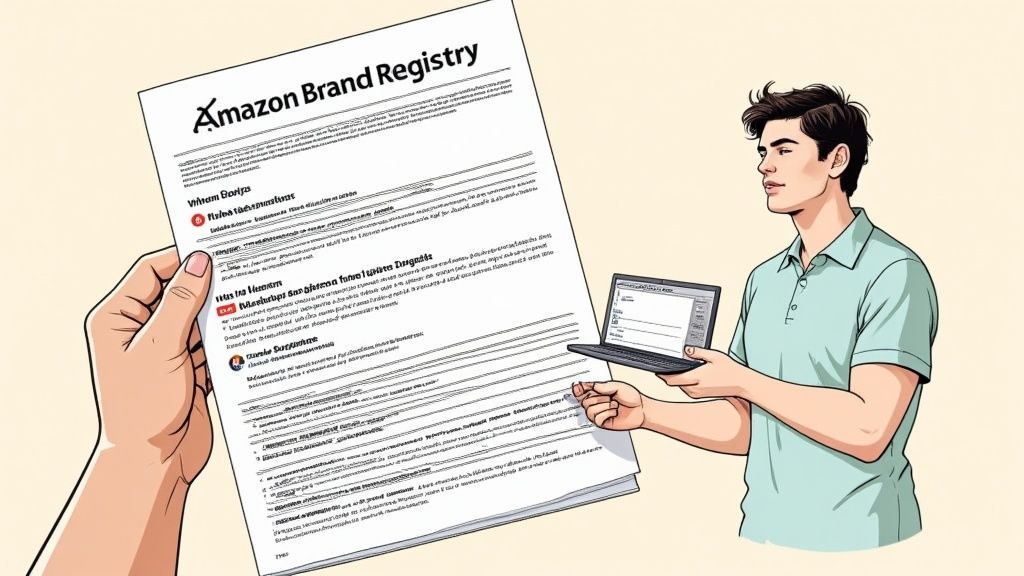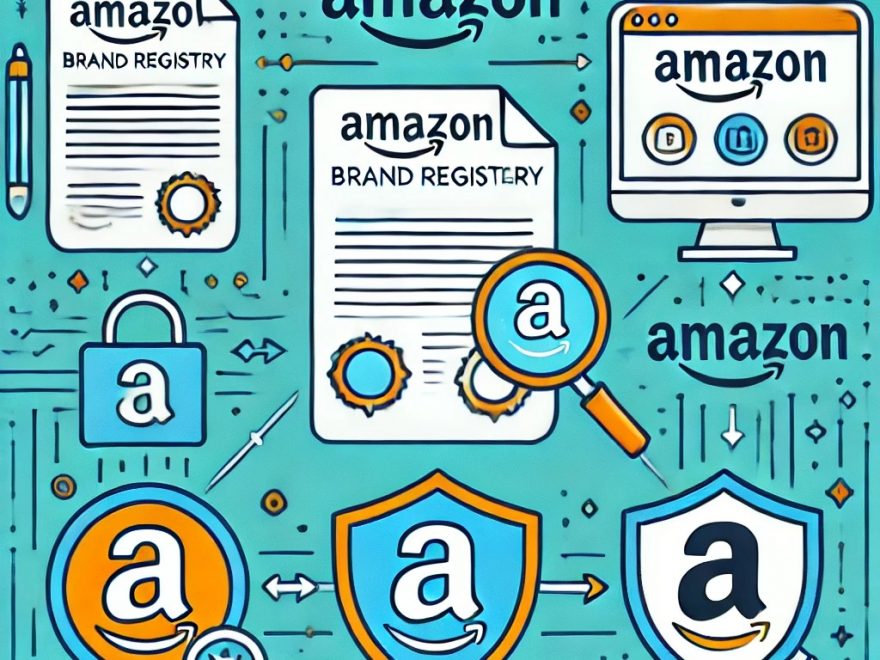Why Brand Registry Matters More Than Ever

Success on Amazon requires more than just great products – it demands strong brand protection. As counterfeiters and unauthorized sellers become more common, brands face growing threats to their reputation and sales. Amazon Brand Registry provides essential tools to safeguard your brand and fuel its growth. Since its 2017 launch, this program has become a critical asset that gives brands much more control than traditional protection methods.
The Evolution of Brand Protection on Amazon
In the past, defending your brand on Amazon meant dealing with infringement issues after they occurred. The process was slow and complex, leaving brands vulnerable. Brand Registry changed this by putting prevention first. The program automatically scans for and removes potential violations before they cause damage. It also makes reporting issues much simpler and faster. For brand owners, this proactive approach has made protecting their products far more effective and manageable.
Real-World Impact: How Brand Registry Drives Success
While meeting Amazon Brand Registry requirements takes some work, the benefits make it worthwhile for committed sellers. Once approved, you gain access to powerful marketing and brand-building tools. A+ Content helps you create richer product descriptions with engaging visuals. Sponsored Brands ads let you run focused campaigns to reach ideal customers. Brand Analytics provides key data on shopper behavior and search trends to inform your strategy. Together, these capabilities help create compelling brand experiences that boost engagement and sales.
Debunking Common Misconceptions
Many sellers think the Brand Registry only helps with counterfeit protection. While that’s important, the program offers much more – it gives you tools to strengthen your brand presence, shape your story, and build deeper customer relationships. Another misconception is that it’s overly complex and expensive. Though trademark registration has costs, the Brand Registry itself is free. Services like eStore Factory can guide you through trademark filing and help you maximize program benefits. When you consider the long-term value of better brand control, improved visibility, and higher conversion rates, the initial investment becomes much more reasonable. Understanding these realities helps brands fully benefit from the Brand Registry’s capabilities.
Navigating Your Trademark Journey
Getting your brand registered with Amazon starts with getting a proper trademark. This essential step helps you access Amazon Brand Registry benefits, but many sellers find the process confusing. Let’s break down the key steps and give you practical tips to help secure your trademark successfully.
Understanding Trademark Types
Before filing, you’ll need to choose between two main trademark types. A word mark protects your brand name itself, such as “ExampleBrand.” This gives you broad protection against others using your name, regardless of how they style it. A design mark covers visual elements like logos or symbols, which can include text, numbers, or letters as part of the design – think of the iconic Apple logo. Your choice depends on how you present your brand to customers and what aspects need protection.
Common Filing Mistakes to Avoid
Getting trademark approval requires careful attention to detail. Simple errors can lead to delays or rejection. Make sure your brand name matches exactly across your application and trademark records. Images are another key area – your brand name must be permanently attached to products or packaging. Temporary solutions like stickers or tags won’t work. For example, if you’re filing for “SuperClean” cleaning products, showing the name on a removable label rather than printed directly on the packaging could get your application rejected. Stock photos and digitally altered images should also be avoided.
Global Trademark Protection
If you sell in multiple countries, trademark protection gets more complex since each country has its own rules. You may need separate trademarks for each market where you do business. While this adds work, it provides stronger global brand protection. For instance, a US clothing brand expanding to Europe would need an EU trademark to fully protect their brand across European markets.
Planning for Time and Cost
While joining the Amazon Brand Registry is free, trademark registration has associated fees. US trademark filing through the United States Patent and Trademark Office (USPTO) typically costs $225-400 per product category. The process usually takes several months to a year. Factor these timelines and costs into your brand strategy early on. For example, if launching a new product, start trademark filing well ahead to access the Brand Registry when you go live. Some sellers work with specialized services like eStore Factory to help navigate the process. Understanding the investment required upfront helps ensure a smoother path to meeting Amazon Brand Registry requirements.
Making Your Brand Registry Application Stand Out

Getting approved for the Amazon Brand Registry takes more than meeting basic requirements. A strong application combines thorough preparation with close attention to detail. Understanding common mistakes and following proven strategies will significantly improve your chances of first-time approval.
Common Rejection Reasons and How to Avoid Them
Small oversights often lead to rejected applications. One frequent issue is when brand names don’t match exactly between the application and trademark record – even minor differences in spaces or symbols can cause problems. For example, if your trademark reads “Cool Shoes” but you submit “Coolshoes”, your application may be rejected. Another key point: your brand name must be permanently attached to products or packaging, not added with stickers. Amazon also won’t accept stock photos or digitally altered images. Addressing these details early helps prevent setbacks.
Organizing Your Documentation: A Practical Approach
Think of your Brand Registry application as putting together an important presentation. Create a clear index of all required materials, including trademark details, brand name, logo files, and product category information. Review each document carefully to ensure perfect alignment with your trademark registration. This organized approach saves time and prevents frustration later.
Presenting Your Brand: Making a Compelling Case
While Amazon focuses mainly on verifying facts, a polished application reflects professionalism. Submit high-quality product photos that clearly show your permanently attached brand name. Professional product photography can make a real difference in presentation. If you need guidance with any part of the process, working with experienced partners like eStore Factory can help ensure your application meets Amazon’s standards.
Ensuring a Smooth Verification Process
Know what to expect during verification. Amazon will contact your trademark correspondent to provide a verification code, which you’ll need to submit back to Amazon. Set up clear communication with your trademark contact beforehand to prevent delays. This simple preparation step can speed up the verification timeline considerably. By planning and addressing potential issues upfront, you can turn Brand Registry requirements from a challenge into a straightforward process.
Maximizing Your Brand Registry Tools
Getting started with Amazon Brand Registry opens up several powerful tools that can help grow your brand and boost sales. While brand protection is important, these tools do much more – they help you tell your brand’s story, connect with customers, and gain key insights into shopping behavior. Let’s explore how to get real results from these tools.
A+ Content: Enhancing Your Product Story
A+ Content stands out as one of the Brand Registry’s most useful features. It lets you move beyond basic product descriptions to create engaging, visual content that connects with shoppers. Instead of just listing specs, A+ Content helps showcase key features, answer common questions, and highlight what makes your brand special. For instance, if you sell coffee makers, you could use A+ Content to tell the story behind the beans, explain the craftsmanship, and describe the coffee experience. This deeper storytelling helps shoppers feel more confident in their purchase and often leads to better sales.
Sponsored Brands: Reaching Your Ideal Customers
Sponsored Brands ads help you connect with shoppers looking for products like yours. These ads show up prominently in search results and let you display multiple products along with your brand logo and custom headline. Beyond just getting seen, these ads help build recognition for your brand. Take an organic skincare brand – they might create a Sponsored Brands campaign targeting “natural face cleanser” searches, with their logo and headline “Discover Radiant Skin Naturally” above a selection of their best cleansers. This focused approach helps reach shoppers most likely to buy.
Brand Analytics: Data-Driven Insights for Strategic Decisions
Through Brand Analytics, you get valuable data about how shoppers search and buy. This helps guide choices about product development, marketing, and keyword usage. The tool shows which search terms bring shoppers to products like yours, what other items they consider, and which customer groups engage most with your brand. You can use these insights to improve your product listings, refine your ads, and boost your sales.
Integrating Your Brand Registry Tools: A Synergistic Approach
These tools work best when used together. For example, you can use Brand Analytics data to create targeted Sponsored Brands campaigns that send shoppers to pages with compelling A+ Content. This creates a smooth experience that helps turn browsers into buyers. While setting up these tools takes time, working with an Amazon expert like eStore Factory can help speed up the process and make the most of Brand Registry’s benefits. For brands serious about succeeding on Amazon’s competitive platform, mastering these tools is key.
Building Your Brand Protection Strategy

Getting approved for Amazon Brand Registry is just the first step in protecting your brand. Think of it like building a house – getting approved is like obtaining the building permit, but you still need to construct and maintain the entire structure. Let’s explore how to take your Brand Registry access and turn it into an effective shield against counterfeits and infringement.
Proactive Monitoring: Staying Ahead of the Curve
Once registered, keeping a close eye on your brand presence becomes essential. Make regular checks for unauthorized sellers or fake products by searching for your items on Amazon and comparing listings against your approved distribution channels. For example, if you only sell through your own Amazon store and one authorized reseller, any other listings likely need investigation. This ongoing monitoring helps catch problems early before they can damage your brand.
Addressing Infringement: Taking Swift Action
When you spot potential infringement, take these key steps: First, document everything with screenshots of the listing, seller details, and other relevant facts. This evidence will support your case when reporting to Amazon. Next, use Brand Registry’s reporting tools to submit a clear infringement notice – Amazon provides specific templates to make this process straightforward. Consider sending the seller a cease and desist letter directly, as this often resolves issues quickly.
Automating Your Brand Protection: Scaling for Growth
Manual monitoring becomes harder as your brand grows. Tools like Brandlox can automate searching for suspicious listings and alert you immediately to potential issues. Their scanning algorithms do the heavy lifting of monitoring Amazon, freeing up your time. It’s similar to having a security system for your home – constant protection even when you’re not actively watching.
Building a Sustainable Strategy: Long-Term Brand Defense
Protecting your brand requires commitment over time. Set aside both time and budget specifically for monitoring and enforcement. Stay consistent with regular checks, quick responses to problems, and updates to your approach as needed. For instance, if you notice frequent issues from certain regions or seller types, adjust your strategy to focus on those specific challenges. This ongoing refinement keeps your brand protection strong and adaptable as threats change. While a Brand Registry provides the foundation, building and maintaining a complete protection strategy ensures lasting success.
Future-Proofing Your Brand Registry Success

Getting set up with Amazon Brand Registry is just the beginning. As Amazon continues to update its policies and features, your brand needs to adapt and grow. Let’s look at key ways to maintain and expand your brand’s success on Amazon for the long term.
Adapting to Amazon’s Changes
Amazon regularly updates how brands manage listings and run ads. To stay current, make it a habit to check Seller Central announcements and follow industry newsletters. For instance, when Amazon introduces new advertising features or policy changes, you’ll be ready to adjust your approach quickly rather than playing catch-up.
Keep Your Trademark Protection Active
Your trademark isn’t permanent – it needs renewal every 10 years in the US to stay valid and maintain your Brand Registry status. Mark these important dates well ahead of time, since missing a renewal deadline could leave your brand vulnerable to infringement and jeopardize your Amazon standing.
Growing Your Protection Strategy
As you add more products and grow sales, your brand protection needs also increase. Consider tools like Brandlox to automatically monitor listings for potential issues. You may also want to expand trademark coverage to include new product categories or brand name variations. Taking these steps helps maintain strong protection as your business expands.
Aligning with Amazon’s Direction
Pay attention to Amazon’s priorities and how they affect brands. Currently, Amazon emphasizes sustainability and social responsibility. Incorporating these themes thoughtfully into your product listings and A+ Content can strengthen your brand’s position and connect with customers who value these qualities.
Using New Tools Effectively
Watch for opportunities to enhance your brand with proven technology solutions. For example, well-implemented AI tools can help personalize recommendations and handle routine customer service tasks. This frees up your team to focus on strategy and growth initiatives.
Following these guidelines helps create an adaptable, well-protected brand presence ready for long-term success on Amazon.
Need help optimizing your Amazon brand strategy? eStore Factory provides expert guidance on Brand Registry requirements, listing optimization, and maximizing sales potential. Contact us today to discuss how we can support your Amazon success.

